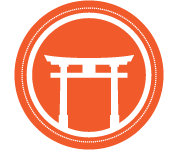What is Shugyo?
Inryoku Volume 6 Issue 8
by Josh Paul, AOSB Head Instructor
Introduction
This month’s issue of Inryoku is another look back at the essays I wrote for my 2004 shodan exam. Last month, I shared my “What is Aikido?” essay. This month, I’ll share my essay about shugyo, the concept of deep mind-body training.
My essay “What is Aikido?” felt familiar. It continued themes and ideas that I’m still thinking about and practicing. However, I don’t recognize the person who wrote this essay about shugyo. It sounds like me, but I haven’t had any of these concerns in so long I wonder why I ever did. In fact, many of the things I say that I was scared of—hitting myself with a jo, dislocating a shoulder, crashing into a wall, among other things—I’ve subsequently done. Some of them more than once!
That these fears have melted away is a testament to aikido’s effectiveness, and the practice’s ability to improve one’s quality of life on and off the mat. I do still worry about injury, but now it is only because it takes so much longer to heal than it did 20 years ago!
Please enjoy my 2004 shodan essay “What is Shugyo?”
PS—The photos are recent. I don’t have any from 2004.
Shuygo is generally translated as “determined training that fosters enlightenment” undertaken “to tighten the slack, toughen the body, and polish the spirit.” For me, this has meant learning to acknowledge and overcome fear—fear of hurting others, fear of hurting myself, and fear of conflict.
My greatest concern when I began training was inadvertently seriously injuring another student. I was clumsy and out-of-shape, and suffered from an inability to coordinate mind and body. Accidentally hurting someone seemed almost inevitable. Likewise, I also feared hurting myself. It was not paired practice that frightened me. Rather, I feared rolling incorrectly and dislocating a shoulder, running into a wall, or simply whacking myself in the head with a jo.
Both fears inhibited my practice for many months—they made it impossible to fully engage my partners as either nage or uke. However, with time and continuous practice, I learned to trust my body, and grew more coordinated and confident. And, after a few injuries, I learned to calmly face and accept this possibility, realizing that, surprisingly, my body was strong enough to recover.
These fears were very conscious concerns. The path to face and overcome them was clear: practice as much as possible, and focus on what is happening rather than what could happen. Each time I left with mat without incident, the fear receded a little more.
Having achieved this, my aikido, nevertheless, was lacking. I felt and appeared meek during practice. This was a less tangible problem: was the source in my technique or in my mind? If I did all the movements of a technique correctly, why did it not work? It was like playing all the notes of a song correctly, but failing to make music.
I began to analyze myself on and off the mat, and, finally taking Sensei Jarman’s advice, began practicing zazen at home and at the dojo. During this period, I discovered that even when I thought I was entering during a technique, I was retreating. This was particularly apparent during weapons practice. I was afraid to engage the conflict. At home, I realized I was often secretly mad or in disagreement with people. I never expressed or tried to discuss the problem, accept the conflict, or find a satisfactory resolution. I ignored it, disregarding my own feelings, and, in the process, the feelings of those around me. Avoiding conflict, in fact, made it impossible for me to truly express any feelings, which seriously affected my marriage.
It was training and a desire to improve that brought me to this understanding. Learning technical movements was not enough—to really begin to practice aikido, I had to change myself, and, simultaneously, aikido helped me to change. Of course, I am still not “cured.” I still hesitate to voice dissenting opinions, and some times, on the mat, my feet stutter with indecision. However, I am aware, and awareness of a problem or, in this case, fear, is a step towards reinvention. Now when I find myself in a potentially contentious moment, instead of ignoring or avoiding it, I can at least relax and center myself, and try to face the problem. It is not always what I want to do, but now that I know I am afraid, I have to.
###


